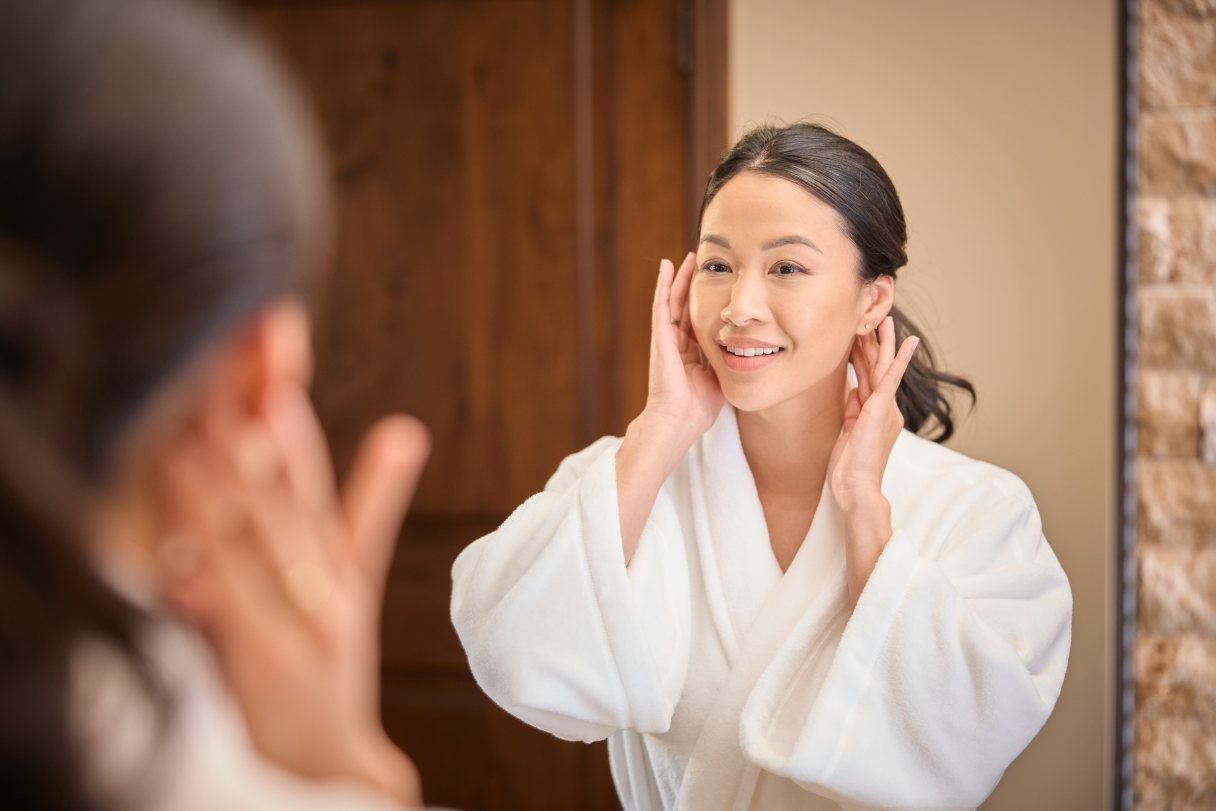Collagen and elastin are two proteins responsible for keeping our skin firm and smooth. As we age, we produce less collagen and elastin, which often results in sagging, crepey skin on the face, neck and other areas of the body. Non-surgical skin tightening can temporarily restore firmer, younger-looking skin by stimulating the production of collagen and elastin, usually with little to no downtime.1
What Is Non-Surgical Skin Tightening?
Non-surgical skin tightening procedures use non-invasive devices to target heat energy into the deeper layers of the skin, causing existing collagen fibers to contract or tighten. The heat also stimulates the body's healing process to produce a new collagen foundation, gradually improving the tone, texture and firmness of moderately lax or sagging skin. Some non-surgical skin tightening treatments also target fibrous tissue to help smooth cellulite.1
FDA-approved skin tightening treatments generally use laser, radiofrequency or ultrasound energies to deliver heat to the sublayers of skin tissue. Treatments can be applied to the following areas of the body:2
- Abdomen
- Arms
- Buttocks
- Face
- Neck
- Thighs
The number of treatments needed will vary based on the technique, patient needs and desired results.2
Benefits
Non-surgical skin tightening treatments offer these benefits:1
- Treatments tone mild to moderately loose skin on the face, neck or body without surgery or scars.
- Most treatments can be performed in-office, often in one hour or less.
- There is a low likelihood of adverse effects when performed by a qualified provider.
- Little to no downtime for recovery is needed.
- Results can last for up to one year or longer, depending on the treatment.
- Procedures are typically less expensive than surgical options.
Limitations
However, these types of treatments also have their drawbacks:1
- Results appear gradually over weeks or months.
- Treatments often must be repeated to maintain results.
- Treatments are not an effective option for advanced skin laxity due to age, pregnancy or weight loss.
5 Popular Non-Invasive Skin Tightening Options
Individual patient costs for non-surgical skin tightening procedures will vary based on your geographic location, your specific provider, the type of procedure(s), the area(s) of the body on which the procedure is performed and the number of treatments required for optimal results. Consult your provider for a thorough understanding of a treatment plan that’s right for you.
1. Ultrasound
Sometimes described as a mini facelift and often used as a preventative against skin laxity, ultrasound skin tightening heats the skin up to 5 millimeters deep to stimulate collagen production on the brow, chin, chest and neck. Treatments are delivered by FDA-approved handheld devices and use ultrasound waves to target the exact layers of skin where treatment will be most effective.1
- In-office treatments can last 30 to 90 minutes.1
- Possible mild side effects include temporary redness, numbness or swelling.1
- Results are visible within two to three months and may last up to a year.1
The national average cost* of ultrasound skin-tightening therapy is $993, but costs can range from $770 to $1,862.3
Calculate the cost of non-surgical skin tightening near you

Explore procedure costs in your area
2. Radiofrequency
Radiofrequency (RF) uses an FDA-approved device to apply RF energy to heat the skin and trigger collagen production in the epidermal layers on the face, neck, hands and body.1 Thermage® and FaceTite® are examples of popular radiofrequency treatments.
- In-office treatments can be done with little discomfort and involve no downtime.1
- Results are gradual, appearing within a few months.1
- Multiple treatments may be required to see optimal results.1
The national average cost* of radiofrequency skin-tightening treatment is $755, but it can range from $582 to $1,448.3
Below is the average cost* per type of radiofrequency therapy:
| Treatment | Average cost | Cost range |
|---|---|---|
| Thermage | $1,2304 | $745 to $5,8784 |
| FaceTite | $4,8483 | $3,725 to $9,2653 |
3. Intense pulsed light (IPL) therapy
Intense pulsed light therapy uses wavelengths of light energy to improve the color and texture of the skin caused by sun damage on the face, neck, hands or chest. IPL may also help reduce the appearance of other skin conditions, including rosacea, age spots or birthmarks.5
RF therapy is often combined with IPL depending on the areas treated and the desired results.1 VelaShape® and VelaSmooth® are examples of popular combination RF/IPL treatments.
- Combination treatments are an efficient way to treat multiple skin conditions simultaneously.1
- In-office treatment is performed with little to no discomfort or downtime.1
- Effects appear gradually and may require multiple treatments for maximum effect.1
- IPL may not be effective on dark or tanned skin.1
The national average cost* of IPL treatment is $126, but it can range from $98 to $243.3
Below is the average cost* per type of combined RF/IPL therapy:3
| Treatment | Average cost | Cost range |
|---|---|---|
| VelaShape | $1,139 | $880 to $2,134 |
| VelaSmooth | $295 | $226 to $569 |
4. Laser resurfacing
Non-ablative skin resurfacing uses a laser to treat wrinkles, scars and age spots. Non-ablative lasers are typically fractionated to administer hyper-targeted heat through thousands of tiny columns called microthermal treatment zones, which allows the skin to heal faster.6
- In-office treatment has little to no downtime.6
- Effects are gradual, appearing over several months.6
- Multiple treatments may be necessary for optimal results.6
The national average cost* for non-ablative laser resurfacing is $1,815 but can range from $995 to $3,678.4
5. Thread lift
A thread lift is a non-surgical procedure in which your provider uses temporary sutures to produce a natural lift in the skin. A thread lift also stimulates the body's natural healing response, causing the body to increase collagen production in the treated areas of the face.7
- In-office procedures may be performed under a local anesthetic.7
- Patients may experience some soreness or swelling, though most can return to work the following day.7
- Results appear within a few weeks.7
The national average cost* of a basic thread lift is $1,761, but the cost can range from $1,392 to $3,361.3
There are several types of FDA-approved thread lifts available, depending on a patient’s needs and the desired outcome:3
| Treatment | Average cost | Cost range |
|---|---|---|
| Silhouette Soft® | $2,963 | $2,263 to $5,658 |
| NovaThread Basic® | $1,847 | $1,422 to $3,485 |
| NovaMesh® | $2,342 | $1,811 to $4,459 |
| NovaLyft® | $2,935 | $2,263 to 5,092 |
Non-Surgical Skin Tightening by Body Part
Not all FDA-approved non-surgical skin tightening techniques can be used for every part of the body:1
- Ultrasound therapy, laser resurfacing and thread lifts are intended for areas of the face, including the brow, chin, neck, jaw and the décolletage (chest).
- Radiofrequency and combination RF/IPL treatments are also intended for use on areas of the face, neck and chest but may also be used on the stomach, legs and arms, as these treatments are able to cover a larger surface area with better results.
Financing Non-Surgical Skin Tightening With the CareCredit Credit Card
When getting a skin tightening treatment or another cosmetic procedure, the CareCredit credit card can help you pay for costs not covered by insurance.** Use our Acceptance Locator to find a doctor or cosmetic specialist near you that accepts CareCredit. Continue your wellness journey by downloading the CareCredit Mobile App to manage your CareCredit account, find a provider on the go and easily access the Well U blog for more great articles, podcasts and videos.
In addition to cosmetic procedures, you can also use your CareCredit credit card for dentistry, pet care, vision, hearing, health systems, dermatology, pharmacy purchases, spa treatments and so much more within the CareCredit network. How will you invest in your health and wellness next?
Author Bio
Anne-Marie Kennedy is a freelance writer with more than 20 years of experience covering health and wellness, personal finance and real estate/investing.







